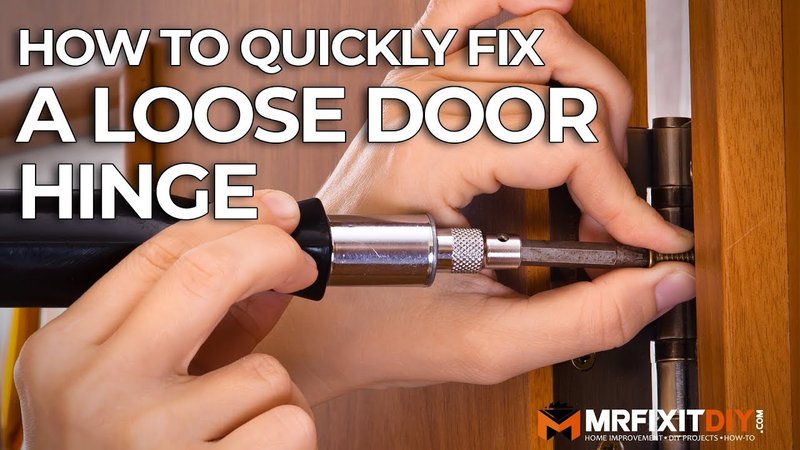
Repairing a loose hinge mortise is a task that’s easier than it sounds, and it’s something most people can tackle on their own with a little guidance. You’ll not only save some money on repairs but also develop a handy skill for future home projects. Let’s dive into how to secure that hinge and restore the functionality of your door, one step at a time.
Understanding the Hinge Mortise
Before we get into fixing the problem, it’s important to understand what a hinge mortise is. A mortise is simply a notch or pocket cut into the door frame where the hinge sits. It creates a snug fit, allowing the door to swing open and closed smoothly. If this mortise becomes loose, the hinge can pull away from the frame, leading to misalignment.
Picture a puzzle piece that doesn’t fit right. If a piece is worn out or damaged, it won’t lock into place, leading to a crooked picture on your wall (or a crooked door in this case). If your door’s hinge is pulling away from the jamb, you’ll want to tighten it up to restore that perfect fit.
Common Signs of a Loose Hinge Mortise
You might be asking, “How do I know if my hinge mortise is loose?” Here are some telltale signs:
- Door Misalignment: If your door doesn’t line up with the frame or it drags on the floor, a loose mortise could be the issue.
- Squeaky Noises: If you hear squeaking sounds when opening or closing, it’s often due to a hinge that’s not secure.
- Visible Gaps: Check for any gaps around the hinge. If you can see light coming through, that’s a clear sign that something needs fixing.
If you notice any of these signs, it’s time to roll up your sleeves and get to work. Ignoring these issues can lead to bigger problems down the road, such as complete misalignment or even damage to the door itself.
Gathering Your Tools
Before diving into the repair, let’s make sure you have everything you need on hand. Here’s a quick list of tools and materials to gather:
- Screwdriver: A proper screwdriver is essential for tightening or replacing screws.
- Wood Glue: This will help reinforce the mortise by adding stability.
- Wood Filler: If the mortise is excessively damaged, wood filler can help fill in gaps.
- Drill: This is handy if you need to create new holes for screws.
- Wood Screws: Make sure you have some replacements if the existing screws are stripped.
Having the right tools will make the process smoother. You don’t want to get halfway through a project and realize you’re missing something!
Steps to Repair the Loose Hinge Mortise
Now that you’re equipped, let’s walk through the repair process step-by-step.
1. Remove the Hinge
Start by carefully unscrewing the hinge from the door and the jamb. Use gentle pressure to avoid damaging the screws, especially if they’re old or rusty.
2. Inspect the Mortise
Once the hinge is off, take a good look at the mortise. Is it cracked or too large? If there’s damage, you’ll want to fill that with wood filler to create a more snug fit for the hinge.
3. Apply Wood Glue
If the mortise is slightly loose but not severely damaged, apply a bit of wood glue inside the mortise. This will help reinforce it.
4. Reattach the Hinge
After the glue has dried according to the manufacturer’s instructions, place the hinge back into the mortise and screw it in tightly. Make sure it aligns well with the door frame.
Using Wood Filler for Damaged Mortises
If your mortise is beyond a simple tightening, you might need to fill it with wood filler. This is especially true if the mortise has large gaps or cracks that could impede the hinge’s ability to hold securely.
Here’s how to do it:
- Clean the Area: Remove any debris or loose wood from the mortise.
- Fill the Mortise: Using a putty knife, fill the mortise with wood filler, smoothing it out flush with the surface.
- Let It Dry: Allow the filler to completely dry before sanding it down to ensure a flat surface.
- Drill New Holes: If needed, drill new holes for the screws once the filler is dry.
With a fully filled and dried mortise, your hinge should have a solid hold when you reattach it.
Preventing Future Issues
Once you’ve got your door working again, you’ll want to take some steps to prevent the problem from coming back.
Consider using longer screws when reattaching the hinge. This will give the hinge more grip into the frame, reducing the risk of it pulling away in the future. Also, check your door regularly for any signs of wear.
You might be wondering how often to do this. A good rule of thumb is to inspect it at least once a year, especially if you live in an area with high humidity, which can cause wood to expand and contract.
Fixing a loose hinge mortise in your door jamb might seem daunting at first, but it’s a straightforward task that can save you from future headaches. With just a few tools and some patience, you can restore your door’s functionality and keep it swinging smoothly. Remember, the key is to take your time and ensure everything fits snugly.
So, next time you notice that wobbly door, you’ll know exactly what to do. Happy repairing!
